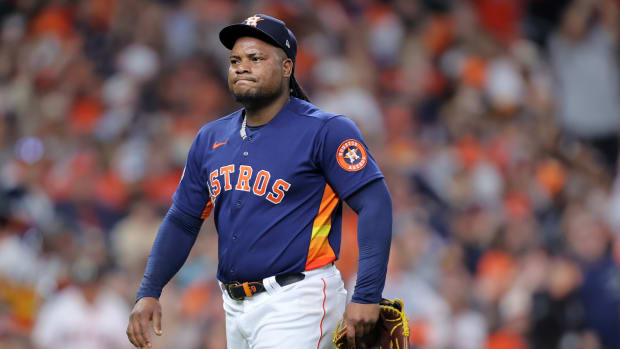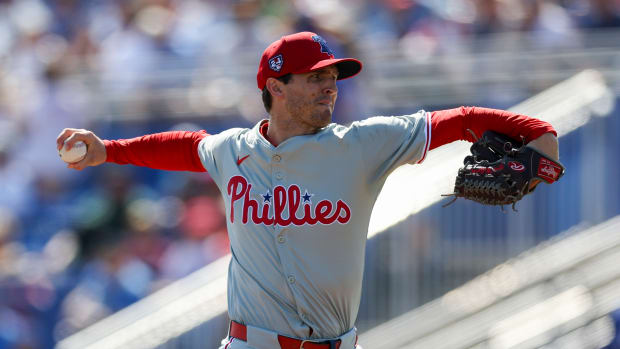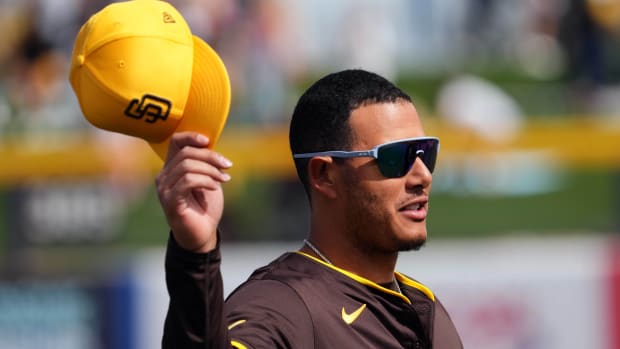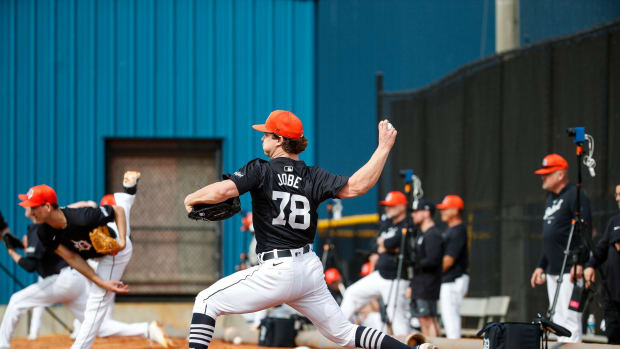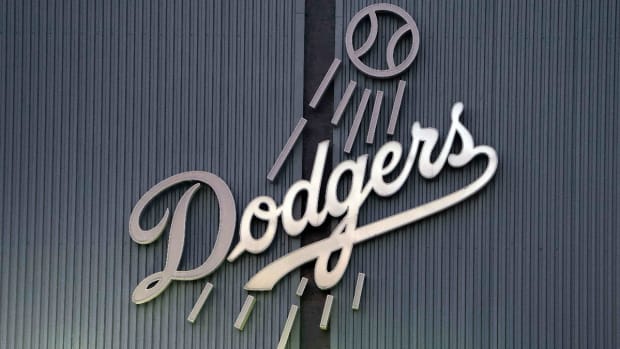Albert Pujols on his resurgence, his All-Star chances and his future
Early this spring, the Angels sensed something different about Albert Pujols. It wasn’t that Pujols, their 35-year-old, $24 million-a-year first baseman, was doing new things; it was that he was doing old ones.
“You just saw the athleticism at first base on the defensive side, which gave you an indication that he was feeling really good,” says manager Mike Scioscia. “We were seeing Albert swing the bat the best since he’s been here. In talking to guys during spring training that have been around him for a long time, like David Freese, they said that this was reminiscent of what he had looked like his whole career. It was exciting.”
He hadn’t played poorly during his first three seasons in Anaheim after signing a 10-year, $240 million free agent contract in December of 2011; he batted .273 with averages of 25 home runs and 91 RBIs. But he hadn’t performed to the supernatural standard he’d set during 11 seasons with the Cardinals, with whom he was nothing short of the best hitter of his generation. With St. Louis, he had hit .328, averaging 40 homers and 121 RBIs, and had finished in the top three in the NL MVP voting eight times, winning the award in '05, '08 and '09.
Hit and Run: Beltre unexpectedly returns, Montgomery shines, more
Age, that undefeated foe, was the popular culprit, but something else was going on. For the majority of his Angels tenure, Pujols had been hampered by a series of injuries to his lower extremities that compromised his production, forcing him to try to generate his old power with only the top half of his body. First there was an injury to his right knee in 2012 that he had to have surgically cleaned up after that season, and which remained painful through last fall. Then he tore the plantar fascia in his left foot, ending his '13 season after just 99 games.
“I have a really unique stance,” Pujols explained during a wide-ranging, 30-minute interview with SI.com last week in Anaheim. “I don’t take a big stride, I don’t have a high leg kick. My lower half produces most of the torque. I need to be healthy with that.”
Pujols finally enjoyed a normal winter this past off-season. “It’s good to be healthy, man, and not have had to worry about any rehab going into the off-season,” he says. “To be able to train the appropriate way to get yourself ready for spring training, and for a long season.”
• COSGROVE: Albert Pujols knows there will never be another Stan Musial
If Scioscia and the Angels could tell right away this season that they were finally getting the Pujols for whom they had paid all that money, his numbers during the first month of the regular season didn’t show it. By the end of April, he was batting .208 with three homers and nine RBIs in 86 plate appearances. A deeper look at the statistics, however, suggested that he was a victim not of poor health or age, but of bad luck. Pujols’s career batting average on balls in play is an even .300, but his BABIP this April was just .206.
“I wasn’t catching any breaks,” he says. “I’d hit bullets right at people, right into shifts. If I had been striking out, rolling over, I’d tell you, man, I really struggled early in the year. I go by the quality of at-bats that I put together every day, day in and day out. I was every night having three and four quality at-bats, and I just didn’t get good results.”
Why having an Election Night will solve All-Star Game voting problem
Those bullets stopped finding gloves once the calendar flipped to May. Since then, his production has been as good as ever, and as the weeks have worn on, it has only improved. Over his most recent 25 games (through Wednesday's action), Pujols is batting .356 with 15 home runs, 30 RBIs and a 1.326 OPS. After that vintage streak, he is now batting .277 overall with an AL-best 23 home runs—four more than Seattle's Nelson Cruz and Houston's Luis Valbuena—and 47 RBIs. While he is making as much contact as ever—on 86.5% of his swings, in line with his elite career norm—his finally healthy legs have restored his power: He is turning 23.5% of his fly balls into homers, the best rate of his career.
“I just feel great,” he says. “I continue to say that this game is hard already, even when you’re 100%. Imagine how hard it is when you’re injured. Especially my knee—I wasn’t able to push off of it, I wasn’t able to put any weight on it. It was rough, it was hard, but I still think I was putting up decent numbers. Just not the Albert Pujols that everybody was expecting—.340, 40 homers. But I still hit 30 home runs, 105 RBIs.”
Pujols’s rejuvenation has him in line to receive an honor that was once an annual fait accompli, but, somehow, is one he hasn't earned in five years: a selection to the All-Star Game. His statistics suggest that he was still good enough to have made one—between 2011, his last year in St. Louis, and '14, he had first half averages of 17 homers and 56 RBIs—but while players like Bryan LaHair, Everth Cabrera and Gaby Sanchez have been among the 116 hitters who have participated in at least one of the last four Midsummer Classics, Pujols has not.
In some measure, Pujols’s All-Star drought has been a result of his competing against the memory of his even greater self, but it is also because he plays a position, first base, that is annually stacked. “There’s so much talent right now in the game,” he says. “I think over the last four years, those four years that I missed, I think my numbers were decent enough to be an All-Star. But I don’t get to choose that. The fans do, and then the coaches and then the manager.”
Even so, while Pujols is famously a team-first type—the majority of his answers in any interview are appended with an entirely genuine assertion of his ultimate goal, which is to bring a championship to Anaheim—he can’t help but admit that he wants to be in Cincinnati this July 14.
Four active players have good chance to join A-Rod in 3,000 hit club
“I miss those times,” he says. “I miss being around young players, I miss being around so many superstars in one room. To be able to go out there and have fun. And knowing that you’re playing a game that’s going to decide whether you’re going to have home field advantage [in the World Series] is even more special. Those are things that I cannot control. Did I ever think I was going to take four years off like that, that it wasn’t going to happen? I mean, I never thought that. But it’s been four years. Hopefully I get the chance this year.”
He has challengers, including the resurgent Prince Fielder and Mark Teixeira, the newly rising Eric Hosmer and the perennially great Miguel Cabrera. Cabrera, Fielder and Hosmer were all ahead of Pujols in the most recent voting update—as was, for some reason, Blue Jays first baseman Justin Smoak—which the league released on Monday. And yet Pujols leads all of them in home runs, and trails only Cabrera in WAR.
Pujols is used to the competition. “I think that’s how it was in the National League, too,” he says. “When I was in the NL, you had [Joey] Votto, Fielder, [Paul] Goldschmidt, Miggy for a little bit. Both leagues have really good players. They’re all having a great year. They all deserve to be there. It’s not going to happen, because it’s not like you have a 50-player, 60-player roster. But we’ll see.”
He particularly admires Cabrera, his main competitor. “I’ve known Miggy for almost 16 years now,” he says. “I remember him during his first spring training with the Marlins, since the Cardinals share a facility with them in Florida. This little baby, this little boy. He was the same kid that he is right now. I know a lot of people probably don’t take Miggy serious because of the way he plays the game, the way he has fun on the field. But he works hard. Great kid. It's just amazing, the way that he’s maintained himself up to this point and worked hard, even through the injuries. I know he had a tough injury last year, I know his numbers were down earlier this year. He’s picking it back up now.”
Pujols has no issue with a voting system that as of now has led to seven of the AL’s nine starting positions being filled by members of the Royals and has helped Hosmer trail Cabrera by only a slim margin. “It’s great to see,” he says. “The fans [in Kansas City] are voting, everyone’s excited about it. I think people need to look around and say, we need to vote for our own team, too. To see so many Royals out there, I wouldn’t use the word embarrassed, but it’s just one of those things. There are so many players on that roster that should deserve to make it—but it is crazy.”
While Pujols jokes that he might yet benefit from some spillover from Kansas City’s fans ballot box stuffing—he grew up just five minutes from Kauffman Stadium—he is pleased to see his teammate, 23-year-old outfielder Mike Trout, among the two current non-Royals starters. “I’m blessed to be able to wear the same uniform, see him every day,” he says. “Nothing surprises me, because I know the ability and the talent that he has. He’s a special kid. What I admire about him the most is the dedication, the work. He wants to get better. No matter what kind of success he has, he works. He’s always asking questions. He just wants to be the best that he can be, and help his team to win. When I retire, he’s going to be chasing a bunch of records and I can say to my kids, yeah, I played with him.”
Pujols, of course, is far less concerned with All-Star politicking than with his and the Angels’ performance. “I’m having more fun, not having to worry about doing therapy, or wondering, How am I going to feel tomorrow, waking up? Am I going to be sore, am I going to be swollen?” One thing to which he does not attribute his outburst is the resolution of the Angels career of Josh Hamilton, even though the troubled slugger’s trade back to the Rangers—on April 27—came just before it began.
“Josh was a great teammate, man,” Pujols said. “It’s just hard to see what happened to him. He’s in a happy place right now. To us, we were more concerned with just making sure that he’s in a good place, and happy. It’s sad what happened to him, and we wish he was here. I don’t believe that contributed to any of my success after all that.”
Power Rankings: Cardinals remain in first place for fourth straight week
Far more important is not just his baseline health, but an understanding of the adjustments he must make to maintain it as he ages. “I remember seven or eight years ago, you wake up and you’re ready to go,” Pujols says. “Now, you feel a little bit more sore. You need to listen to your body a little more. I can’t get in the weight room like I used to and work out for three and a half hours, or work five hours every day in the off-season. That’s something I had to adjust. Before, I used to go out there and kill myself. I think every ballplayer goes through that—and you don’t even have to be a player, you can just be a regular guy, and still you have to adjust to your body aging.”
For now, Pujols seems to have figured out how to be productive—if not quite as singularly so as in his prime—even as he ages, which is something that many stars never do. His contract, which has six years and $175 million remaining on it after this season, also doesn’t seem as potentially onerous as it once did. “I still feel that I have a lot in my tank, that my tank is not empty,” he says. “I know that.”
What will Pujols look like by 2021, when he is 41 years old? “It’s hard for me to even imagine five years from now,” he says. “That’s not me. I don’t like to plan the future. I pretty much let each day go and try to live one day at a time, be blessed that I’m here today, playing this game. Then flip the page and get ready to do the same thing tomorrow.”
While his current health and form have encouraged him, he still does not entirely rule out the idea that he might retire before his contract is through, an idea—unfathomable to most, because it would mean forfeiting tens of million of dollars—that he has periodically broached in recent years. “If I can’t perform at the level I know I can, and compete the right way, I’m not going to stick around and embarrass myself in this game,” he says. “This game has given me so much. The last thing I want to do is disrespect this game, or not be able to compete anymore. But I’m telling you, man, I still have a lot of good games left, and a lot of good things can happen if I can stay healthy.”
This season’s first half has confirmed that reports of Pujols’s demise have been greatly exaggerated. He is now back to quickly revising the game’s scrolls; this season alone, he has passed Jimmie Foxx, Mickey Mantle, Willie McCovey, Frank Thomas and Ted Williams on the all-time home run list, and his 543 now rank him 16th. A deserved return to the All-Star Game, after a once unthinkable five-year absence, ought to be the next of his many honors to come.































